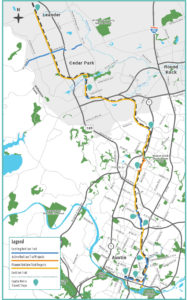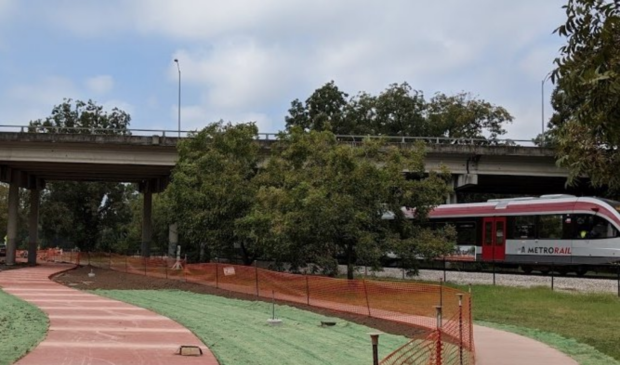A long time coming, Red Line Parkway could be completed by decade’s end
Wednesday, January 27, 2021 by
Jonathan Lee The City Council Mobility Committee heard an update on the Red Line Parkway last week, one of the city’s most anticipated urban trail projects. Austinites can look for significant progress on the trail this year with new segments under development and the Red Line Parkway Initiative beginning its Parkway Plan process.
“It’s a pretty ambitious undertaking for completing this whole corridor,” Urban Trails Program Manager Katie Wettick said. Council members at the meeting expressed excitement about the project and offered to help with any challenges during its implementation.
Though the trail is still mostly incomplete, more is on the way soon. The Lower Boggy Creek trail segment, between 12th Street and Rosewood Avenue, will open this February and will be Austin’s first urban trail with a two-way bike path and a separate pedestrian path, which Wettick said “allows for a more comfortable experience.”
Another chunk of trail from Braker Lane to the Northern Walnut Creek Trail is in the design phase, which is 30 percent complete. This segment, which will be particularly helpful on Austin FC game days, Wettick noted, connects the Q2 Stadium, the Domain area, the forthcoming Broadmoor development, and the future Red Line stations at Broadmoor and the stadium.
Completed segments include the Upper Boggy Creek trail from the MLK Red Line Station to 12th Street, which opened in 2019, as well as pieces in Leander, Cedar Park, downtown and East Austin.
If things go as planned, the full trail will be in place by the end of the decade, though there could be interim sections like bike lanes on streets. When completed, the Red Line Parkway will stretch 32 miles along Capital’s Metro’s Red Line from downtown Austin to Leander.
The implementation timeline depends on securing more funding from local, state and federal governments; private donors; and the 2020 active mobility bond, whose fund allocation will be decided later this year.
Wettick and Red Line Parkway Initiative Executive Director Tom Wald said that the most challenging part of building the trail is right-of-way acquisition, which can be tricky to negotiate and expensive to buy. “In an area that’s already developed,” Wettick said, “it’s really hard to find the little space that’s available.” There are also “competing interests” with Capital Metro, Wald said, since they aim to eventually double-track much of the Red Line.
 The trail has been a long time coming. Capital Metro approved the right of way for the trail in 2004, and the plan was to have the full 32-mile trail finished by 2019. In 2017, because of the scant progress made, the Red Line Parkway Initiative was formed to help push the trail along.
The trail has been a long time coming. Capital Metro approved the right of way for the trail in 2004, and the plan was to have the full 32-mile trail finished by 2019. In 2017, because of the scant progress made, the Red Line Parkway Initiative was formed to help push the trail along.
In 2019, City Council passed a resolution to partner with the initiative. Though the agreement has yet to be finalized, Wettick assured it will be done soon and added that the city and the nonprofit have been working closely together. The partnership is modeled after the city’s deal with the Shoal Creek Conservancy, which works to develop and maintain the Shoal Creek Trail.
The Red Line Parkway Initiative has four main goals this year: plan, fund, build and activate the parkway. Its Parkway Plan, a comprehensive vision for the trail that will launch this year, aims to ensure all of these things get accomplished. The initiative hopes the city will adopt the plan next year. The plan will be funded by private money and designed with the help of consultants.
Wald said there will be many chances for the community to get involved throughout the Parkway Plan process. He also hopes to host events on the parkway itself as soon as public health conditions allow.
The initiative also plans to rename itself this year. A statement on the group’s website explains that the term Red Line, for some, “evokes the racist practice of redlining,” so with help from the public, they aim to change the name.
The Austin Monitor’s work is made possible by donations from the community. Though our reporting covers donors from time to time, we are careful to keep business and editorial efforts separate while maintaining transparency. A complete list of donors is available here, and our code of ethics is explained here.
You're a community leader
And we’re honored you look to us for serious, in-depth news. You know a strong community needs local and dedicated watchdog reporting. We’re here for you and that won’t change. Now will you take the powerful next step and support our nonprofit news organization?


 The trail has been a long time coming. Capital Metro approved the right of way for the trail in 2004, and the plan was to have the full 32-mile trail fini
The trail has been a long time coming. Capital Metro approved the right of way for the trail in 2004, and the plan was to have the full 32-mile trail fini




